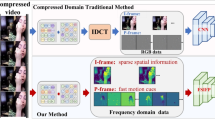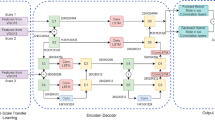Abstract
Considerable progress has been made toward developing standard dynamic range (SDR) blind video quality assessment (BVQA) models that do not require any baseline reference for quality prediction. However, there is no such method for the high dynamic range (HDR) content. Unlike SDR video, HDR video represents a high-fidelity representation of the real-world scene by preserving the wide luminance range and color gamut. Therefore, SDR BVQA models are not suitable for HDR BVQA. Towards ameliorating this, a first-of-its-kind BVQA model for HDR content is presented in this work. The proposed HDR blind video quality model (HDR-BVQM) is inspired by the spatio-temporal natural scene statistics model, previously employed in SDR blind quality assessment metrics. To build our proposed model, we first develop a comprehensive subjective HDR video quality dataset, including 228 distorted videos generated through three different (H.264, HEVC, packet drop) distortion processes from 19 pristine HDR videos. The developed dataset is then used to extract HDR relevant features, which vary in different distortion types, to train and test the proposed HDR-BVQM. The features are based on the pointwise, pairwise log-derivative, and motion coherence based statistics. Finally, detailed validation and performance comparison is performed with full-reference HDR and no-reference SDR quality assessment methods. The results reveal that the quality prediction by HDR-BVQM correlates with the human judgment of quality.



Similar content being viewed by others
References
(2012) Recommendation ITU-R BT ITU. 500-13: Methodology for the subjective assessment of the quality of television pictures. International Telecommunication Union, Technical Report
(2008) ITUT Rec. P. 910: Subjective video quality assessment methods for multimedia applications. International Telecommunication Union, Geneva, 2
(2018) Recommendation ITU-R BT ITU. 2100-2: Image parameter values for high dynamic range television for use in production and international programme exchange. International Telecommunication Union, Technical Report
Aydın TO, Mantiuk R, Seidel H-P (2008) Extending quality metrics to full luminance range images. In: Human vision and electronic imaging xiii, vol. 6806, International Society for Optics and Photonics1, pp 68060b
Aydin TO, Mantiuk R, Myszkowski K, Seidel H-P (2008) Dynamic range independent image quality assessment. ACM Trans Graph (TOG) 27(3):69
Aydin TO, Čadík M, Myszkowski K, Seidel H-P (2010) Video quality assessment for computer graphics applications. Acm Trans Graph (Tog) 29(6):1–12
Azimi M, Banitalebi-Dehkordi A, Dong Y, Pourazad MT, Nasiopoulos P (2018) Evaluating the performance of existing full-reference quality metrics on high dynamic range (HDR) video content. arXiv preprint arXiv:1803.04815
Boitard R, Pourazad MT, Nasiopoulos P, Slevinsky J (2015) Demystifying High-Dynamic-Range technology: A new evolution in digital media. IEEE Consum Electron Mag 4(4):72–86
Ballestad A, Boitard R, Damberg G, Stojmenovik G (2019) Advances in HDR display technology for cinema applications including Light-Steering projection. Inf Disp 35(3):16–19
Bampis CG, Gupta P, Soundararajan R, Bovik AC (2017) Speed-qa: Spatial efficient entropic differencing for image and video quality. IEEE Signal Process Lett 24(9):1333–1337
Bong DBL, Khoo BE (2015) Objective blur assessment based on contraction errors of local contrast maps. Multimed Tools Appl 74(17):7355–7378
Chang C-C, Lin C-J (2011) LIBSVM: A library for support vector machines. ACM Trans Intell Syst Technol (TIST) 2(3):27
Chikkerur S, Sundaram V, Reisslein M, Karam LJ (2011) Objective video quality assessment methods: a classification, review, and performance comparison. IEEE Trans Broadcast 57(2):165–182
Čadík M, Aydin TO, Myszkowski K, Seidel H-P (2011) On evaluation of video quality metrics: an HDR dataset for computer graphics applications. In: Human Vision and Electronic Imaging XVI, vol 7865, International Society for Optics and Photonics, pp 78650R
Fan Q, Luo W, Xia Y, Li G, He D (2019) Metrics and methods of video quality assessment: a brief review. Multimed Tools Appl 78 (22):31019–31033
Froehlich J, Grandinetti S, Eberhardt B, Walter S, Schilling A, Brendel H (2014) Creating cinematic wide gamut HDR-video for the evaluation of tone mapping operators and HDR-displays. In: Digital photography x, vol 9023, International Society for Optics and Photonics, pp 90230x
Fraunhofer HHI. H.265/HEVC Reference Software. https://hevc.hhi.fraunhofer.de/svn/svn_HEVCSoftware/
Hanhart P, Řeřábek M, Ebrahimi T (2015) Towards high dynamic range extensions of HEVC: subjective evaluation of potential coding technologies. In: Applications of digital image processing XXXVIII, vol 9599, International Society for Optics and Photonics, pp 95990G
Seshadrinathan K, Soundararajan R, Bovik AC, Cormack LK (2010) Study of subjective and objective quality assessment of video. IEEE Trans Image Process 19(6):1427–1441
Karsten Suehring. H.264/AVC Reference Software. http://iphome.hhi.de/suehring/tml/
Kulupana G, Mir J, Fernando A, Talagala DS, Arachchi HK (2016) A model based error resilience scheme for HDR video transmission over error prone channels. In: IEEE international conference on consumer electronics-Asia (ICCE-asia), IEEE, pp 1–2
Kundu D, Ghadiyaram D, Bovik AC, Evans BL (2016) No-reference image quality assessment for high dynamic range images. In: 2016 50Th asilomar conference on signals, systems and computers, IEEE, pp 1847–1852
Lasserre S, LeLéannec F, Francois E (2013) Description of HDR sequences proposed by Technicolor. ISO/IEC JTC1/SC29/WG11 JCTVC-p0228], IEEE, San Jose, USA
Loh W-T, Bong DBL (2018) An error-based video quality assessment method with temporal information. Multimed Tools Appl 77(23):30791–30814
Mir J, Kulupana G, Talagala DS, Arachchi HK, Fernando A (2016) Impact of channel errors on single-layer and two-layer hdr video transmission architectures in error prone networks. In: 2016 IEEE International conference on consumer electronics-asia (ICCE-asia), IEEE, pp 1–4
Mittal A, Moorthy AK, Bovik AC (2012) No-reference image quality assessment in the spatial domain. IEEE Trans Image Process 21(12):4695–4708
Moorthy AK, Bovik AC (2011) Blind image quality assessment: from natural scene statistics to perceptual quality. IEEE Trans Image Process 20 (12):3350–3364
Mir J, Talagala DS, Fernando A, Arachchi HK (2019) A comprehensive study and performance evaluation of HDR video coding. Arab J Sci Eng 44(3):2427–2444
Mukherjee R, Debattista K, Bashford-Rogers T, Vangorp P, Mantiuk R, Bessa M, Waterfield B, Chalmers A (2016) Objective and subjective evaluation of high dynamic range video compression. Signal Process Image Commun 47:426–437
Mittal A, Saad MA, Bovik AC (2015) A completely blind video integrity oracle. IEEE Trans Image Process 25(1):289–300
Narwaria M, Mantiuk R, Da Silva MP, Le Callet P (2015) HDR-VDP-2.2: a calibrated method for objective quality prediction of high-dynamic range and standard images. Journal of Electronic Imaging 24(1):010501
Narwaria M, Da Silva MP, Le Callet P (2015) HDR-VQM: An Objective quality measure for high dynamic range video. Signal Process Image Commun 35:46–60
Pan X, Zhang J, Wang S, Wang S, Zhou Y, Ding W, Yang Y (2018) Hdr video quality assessment: Perceptual evaluation of compressed hdr video. J Vis Commun Image Represent 57:76–83
Soong H-C, Lau P-Y (2017) Video quality assessment: a review of full-referenced, reduced-referenced and no-referenced methods. In: 2017 IEEE 13Th international colloquium on signal processing & its applications (CSPA), IEEE, pp 232–237
Soundararajan R, Bovik AC (2012) Video quality assessment by reduced reference spatio-temporal entropic differencing. IEEE Trans Circuits Syst Video Technol 23(4):684–694
Saad MA, Bovik AC, Charrier C (2014) Blind prediction of natural video quality. IEEE Trans Image Process 23(3):1352–1365
Sharifi K, Leon-Garcia A (1995) Estimation of shape parameter for generalized gaussian distributions in subband decompositions of video. IEEE Trans Circuits Syst Video Technol 5(1):52–56
UHD Premium Specifications https://hometheaterreview.com/uhd-alliance-releases-official-ultra-hd-premium-spec/
Video Quality Experts Group et al (2000) Final report from the video quality experts group on the validation of objective models of video quality assessment. In: VQEG meeting, Ottawa, Canada, March 2000
Wang Z, Bovik AC, Sheikh HR, Simoncelli EP (2004) Image quality assessment: from error visibility to structural similarity. IEEE Trans Image Process 13(4):600–612
Zhang Y, Chandler DM (2013) No-reference image quality assessment based on log-derivative statistics of natural scenes. J Electron Imaging 22(4):043025
Acknowledgments
This work was supported by the project entitled “Brain Activity Analysis in response to High Dynamic Range content using Electroencephalography” funded by the Higher Education Commission (HEC) of Pakistan under the “Start-Up Research Grant Program” (21-1951/SRGP/R&D/HEC/2018).
Author information
Authors and Affiliations
Corresponding author
Additional information
Publisher’s note
Springer Nature remains neutral with regard to jurisdictional claims in published maps and institutional affiliations.
Rights and permissions
About this article
Cite this article
Aamir, N., Mir, J., Nizami, I.F. et al. HDR-BVQM: High dynamic range blind video quality model. Multimed Tools Appl 80, 27701–27715 (2021). https://doi.org/10.1007/s11042-021-11040-6
Received:
Revised:
Accepted:
Published:
Issue Date:
DOI: https://doi.org/10.1007/s11042-021-11040-6




